Dirty fabric blinds can be an eyesore, making any room look messy. Dust and stains build up fast especially near kitchens or bathrooms and many people struggle with how exactly to clean them without damage.
Fabric blinds need a bit more care than regular window coverings because they have delicate fibers that trap dirt easily. Learning the right way to Clean Fabric Blinds makes tasks easier at home, saving both effort and time.
This guide shares helpful tips on simple dusting methods, stain removal tricks, and deep-clean strategies suited for different fabrics around the house. Readers will soon find cleaning their fabric blinds simpler than ever before.
Key Takeaways
- Regularly dust fabric blinds with a microfiber cloth or vacuum upholstery brush, gently working from top to bottom; monthly cleaning prevents buildup of dirt and grime.
- Remove tough stains by lightly dabbing them with mild dish soap mixed in warm water (1 teaspoon soap per 2 cups water), testing first on an unnoticeable area to avoid discoloration.
- Deep-clean heavily soiled blinds safely by fully submerging them for one hour in lukewarm water blended with mild detergent, then rinsing thoroughly and air drying flat before reinstalling.
- For difficult-to-reach spots, use extension tools such as wand-like dusters or vacuum hose attachments instead of climbing ladders; vertical blinds clean best using downward strokes from top slat to bottom.
- Different fabrics need specific care: polyester can handle gentle soaking, while delicate materials like silk or linen require professional dry-cleaning methods only.
Understanding Fabric Blinds

Fabric blinds might seem simple, but different styles call for specific cleaning methods. Most homeowners struggle with stains, dust, and tricky fabrics when keeping blinds spotless.
Types of Fabric Blinds

Homeowners have many fabric window treatments to choose from. Roller blinds wrap neatly around a casing, and pull cords easily raise or lower them. Roman blinds lay flat when lowered but create soft pleats as they lift upward; similar in style, pleated blinds resemble folded concertinas with sharp horizontal folds.
Panel blinds feature oversized sliding panels ideal for large windows or room dividers, while vertical blinds use hanging slats commonly made of woven fabric or fabric bonded onto plastic strips.
Common Challenges in Cleaning Fabric Blinds
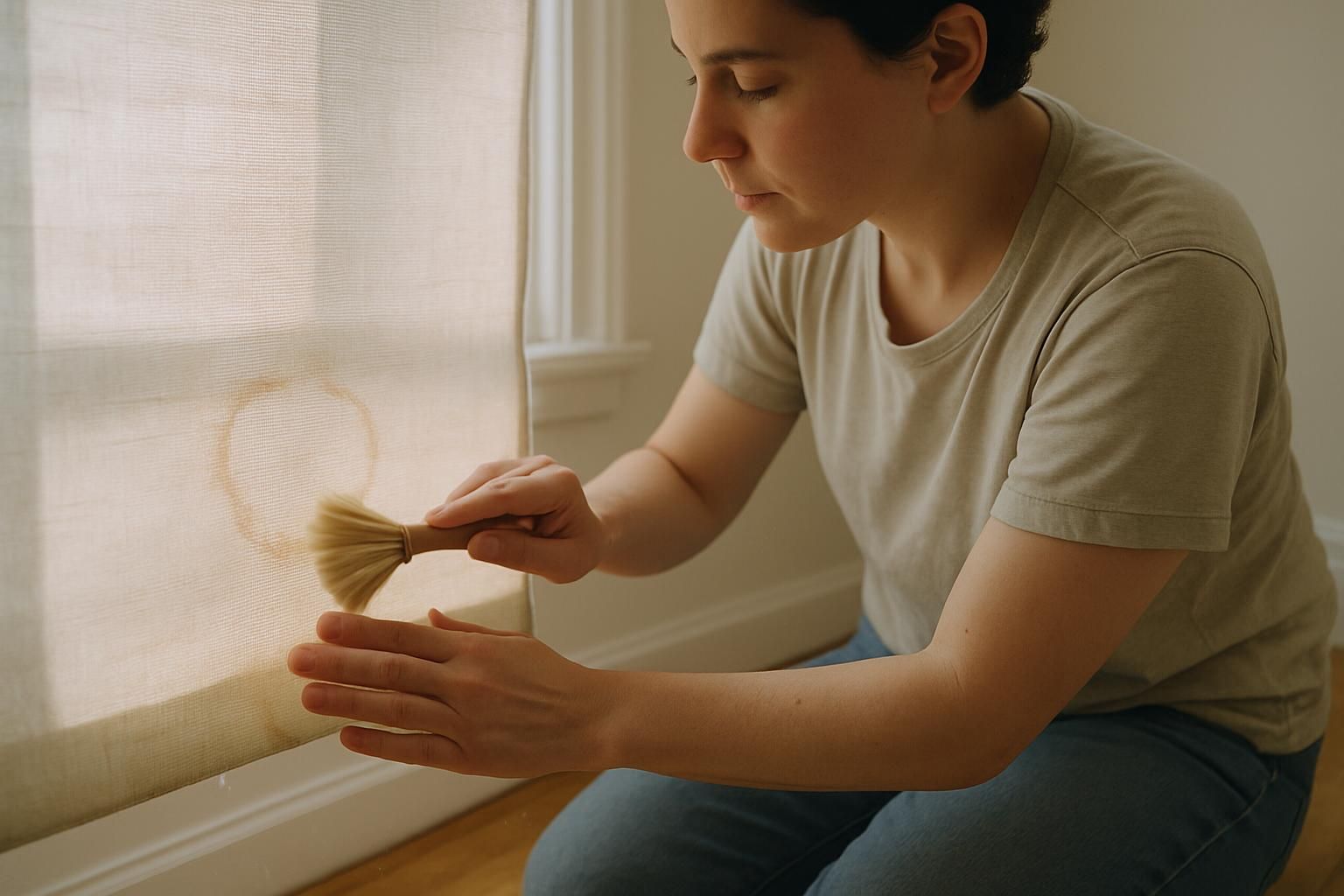
Fabric window coverings need delicate cleaning methods, which brings some common hurdles. Dust and dirt settle easily on fabric blinds due to their soft textures and require careful handling to avoid damage.
Fabric blinds may have moisture-resistant treatments that shield them a bit but still demand frequent upkeep for best results. Immediate stain removal techniques matter greatly; ignoring spills like juice or coffee allows permanent marks to form quickly.
Fabric blind maintenance differs sharply from caring for wood or metal slats. Wooden or vinyl blinds allow soaking in water without issues, but fabric ones warp or detach if soaked fully.
Sensitive cleaning helps prevent distortion and shrinking of materials such as polyester and cotton blends. Gentle handling is crucial because vigorous scrubbing can ruin delicate fabrics completely, especially those lacking protective coatings for fabric blinds.
Addressing these challenges involves proper preparations before starting the actual clean-up process listed next under “Preparing Fabric Blinds for Cleaning.”
Preparing Fabric Blinds for Cleaning
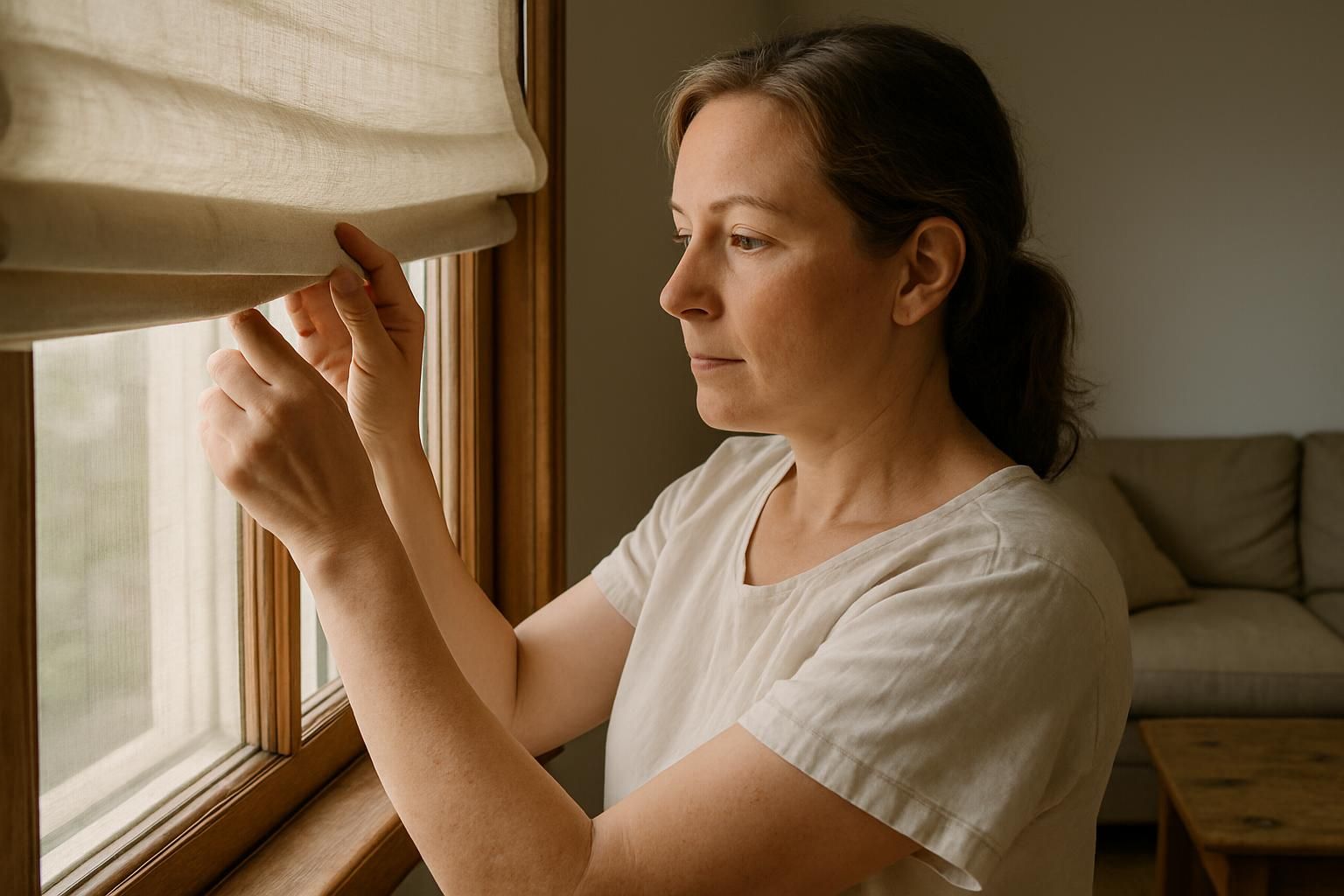
Before grabbing any cleaning tools, homeowners need a simple game plan to avoid accidental damage. A quick prep makes the entire task smoother and keeps blinds looking sharp.
Tools and Materials You’ll Need
Effective cleaning of fabric blinds starts with having the correct gear at hand. This set of tools makes tasks easier and produces better results:
- Vacuum cleaner: Use a vacuum with a hose and upholstery brush attachment to gently remove dust and dirt from the blind surface without damage.
- Microfiber cloths: These soft cleaning cloths attract and trap dust, ideal for wiping blinds without leaving lint or scratches behind.
- Small bowls: Bowls help mix cleaning solutions like liquid detergent diluted in water or baking soda pastes, keeping cleaners within easy reach during spot removal tasks.
- Dishwashing liquid: Ordinary dish soap effectively removes common stains such as food smudges or fingerprints when combined with warm water.
- Baking soda: A popular and safe household staple that tackles stubborn odors and grease marks using mild abrasive action—perfectly safe on most fabric blinds.
- Upholstery cleaner: Specially-formulated spray products designed to clean tougher stains safely on upholstered furniture work well on fabric blinds, restoring their original look.
- Fabric cleaner or stain remover solution: Ideal for targeting specific tough spots; homeowners should select options labeled clearly for use on window fabrics to avoid discoloration or fiber damage.
- Dusting brush: A handheld dusting brush helps loosen surface dirt trapped in delicate textiles gently yet effectively while protecting blind materials during cleaning routines.
- Cleaning solution mix kit: A simple blend of mild detergent and warm water handles routine maintenance safely without harsh chemicals that could harm kids or pets.
- Clean towels for drying purposes after washing steps are complete. Always clean thoroughly dried surfaces to prevent mold growth from moisture residues that remain if left unattended for too long. Regular household habits help keep homes maintained, clean, and neat; this impresses visitors during each visit.
Initial Steps Before Cleaning
After gathering all necessary tools and materials, homeowners can now prepare fabric blinds for a thorough cleaning. Following these simple yet important steps sets the best stage for successful fabric blind maintenance:
- Close horizontal blinds completely or pull vertical blinds fully open before starting. Tilt slats slightly to expose as much of the fabric surface as possible.
- Examine each section carefully to identify stains that need attention, such as food particles, sticky fingerprints from children, or insect droppings.
- Vacuum off loose dust using an upholstery brush attachment; start from the top and move downward in steady strokes to avoid spreading dirt.
- Flip slats over after vacuuming one side so that both front and back surfaces stay equally clean.
- Prepare the work area around windows with towels or drop cloths to catch falling dust or cleaning solution drips.
- Spot-check a less noticeable part of the blinds first if using any new cleaning product. This step avoids unwanted discoloration or damage to delicate window treatments.
- Pull furniture away from windows temporarily to allow clear access during dust removal and stain treatment without obstructions.
- Wear gloves when using mild dish soap mixed with water for spot cleaning areas marked by stains or marks left by spills.
- Open windows slightly for good ventilation if using liquid cleaning solutions that may carry strong odors during initial stain treatments.
- Keep young children and pets safely away from the workspace during cleaning procedures involving ladders, buckets, wires, or slippery floors.
Regular Maintenance for Fabric Blinds

Fabric blinds build up dust faster than kids track mud inside after rain. A regular routine makes blind maintenance quick and hassle-free.
Dusting Techniques
Dusting fabric blinds each month keeps dirt from building up. A feather duster, microfiber mitt, or even an old sock can work great for quick dust removal. Moving in an S-pattern across each blind helps trap more grime with less hassle.
For tough corners and edges, a soft non-abrasive cloth easily wipes off stubborn dust that basic tools may miss. Regular upkeep using these cleaning fabric blinds at home methods takes just minutes but prevents deep stains later on.
How to Vacuum Fabric Blinds
Using a vacuum with a brush attachment makes blinds cleaning simple and quick. Homeowners can start from the top slat and move downward to clear dust without spreading dirt everywhere.
Flip fabric shades carefully to vacuum behind each slat as well, clearing hidden grime effectively. Properly applying these fabric blind cleaning tips keeps window treatments spotless and fresh.
For hard-to-clean spots that vacuums miss, spot cleaning is essential for good fabric blind care.
Spot Cleaning for Fabric Blinds

Accidents happen juice splashes and muddy fingers touch fabric blinds, leaving small yet stubborn stains. Tackle these spots without fancy products using a smart approach.
Identifying Stains
Food spills, sticky handprints, or insect droppings often appear on fabric blinds in family homes. Checking blinds regularly after meals or playtimes helps simplify stain removal during spot cleaning.
Choosing the Right Cleaning Solution
Picking the best fabric blind spot cleaner does not have to be tricky. A simple homemade cleaner involves mixing 2 cups of lukewarm water with 1/4 teaspoon or less of dish soap.
White vinegar mixed with warm water can serve as a natural solution, safe around kids and pets. Mild laundry detergent diluted in water is another effective stain remover already available at home.
For tougher stains, consider using nontoxic, fabric-safe cleaning products available at local stores. Always test any new product on a hidden area first to maintain the fabric’s appearance and avoid damage.
Cleaning Stains with Dish Soap and Water
Kids, pets, and busy families often leave tough stains on fabric blinds. With dish soap and water, homeowners can easily tackle these spots using common household methods:
- Identify the stain first juice spills differ from dusty fingerprints or food splatters to choose the best treatment.
- Test a small, hidden spot with soapy water to check if colors bleed.
- Mix 1 teaspoon of mild dish soap (such as Dawn) into 2 cups of warm water to form an effective cleaning solution.
- Support the stained area with one hand, and gently dab with a soft cloth dipped in the solution. Avoid rubbing to prevent stretching the fabric.
- For difficult spots like spaghetti sauce or dried chocolate milk, sprinkle baking soda lightly onto the damp stain and wait about 15 minutes before removing the residue.
- Rinse well by wiping with a fresh, barely damp microfiber cloth; leftover soap can attract dust and dirt later.
- Allow blinds to air dry completely after treatment.
Simple methods make deep cleaning easier for busy households.
Deep Cleaning Methods
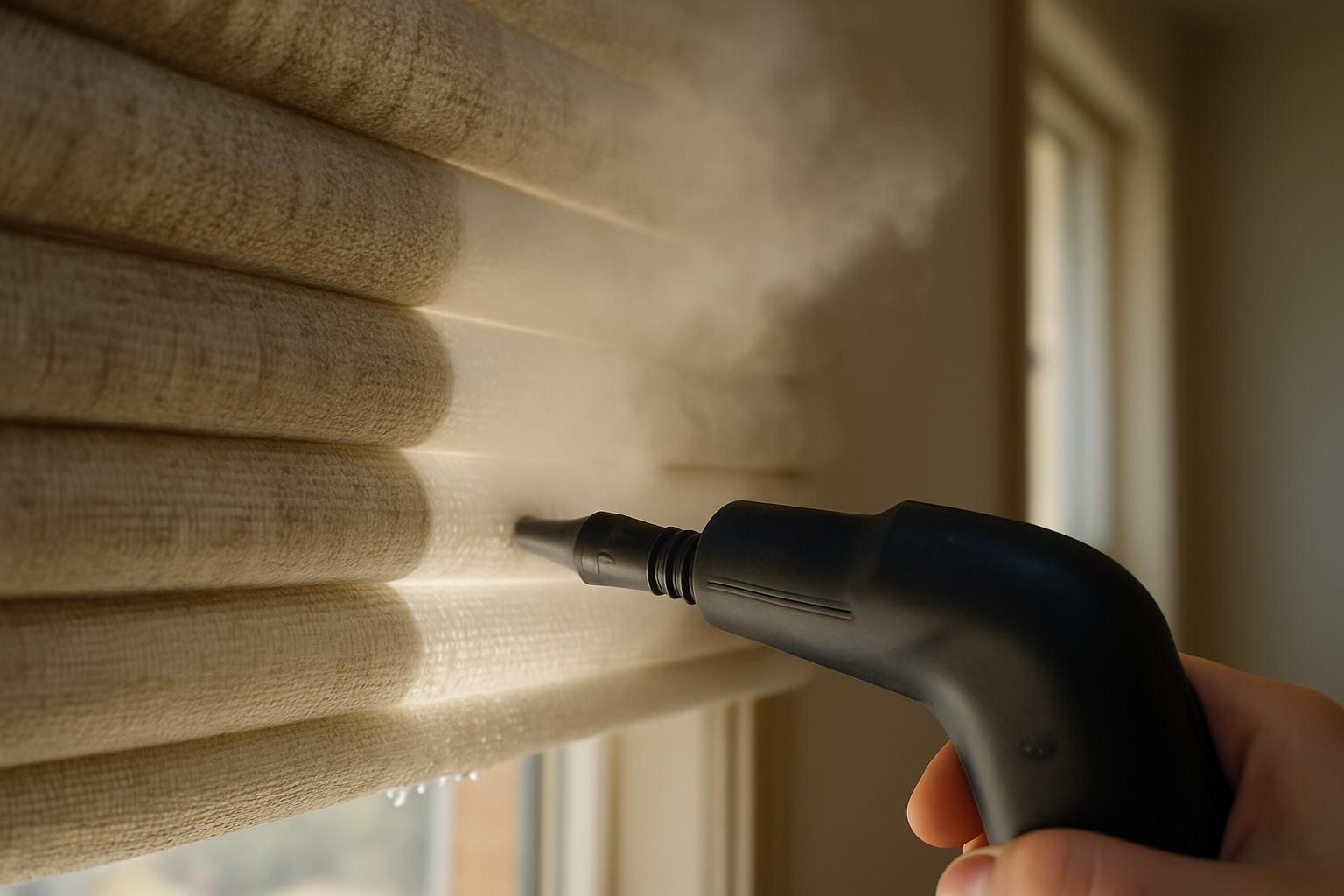
Sometimes fabric blinds need more help than a quick wipe. Deep cleaning can restore freshness and keep them looking like new without too much effort.
Soaking Method for Thorough Cleaning
Fabric blinds can collect dust, grease, and stains over time. A thorough soaking method removes stubborn dirt and restores freshness.
- Remove the fabric blinds carefully from their fixtures.
- Fill a bathtub or large basin with warm water and add mild dish soap to form suds.
- Immerse the blinds fully in the soapy solution, ensuring all parts get saturated evenly.
- Allow the blinds to soak for about one hour. This process loosens dirt effectively.
- If necessary, gently scrub difficult areas using a soft brush or microfiber cloth.
- Rinse each blind thoroughly with clean, lukewarm water until all soap is removed.
- Air dry the blinds by laying them flat on towels or hanging them in indirect sunlight until completely dry before rehanging.
Cleaning Without Taking the Blinds Down
Removing blinds for cleaning can be a hassle. Keeping them installed saves time and energy while achieving excellent results.
- Dust the blinds once a week to minimize buildup and ease deep cleaning later.
- Use a vacuum attachment to remove dust; vacuum monthly to maintain clarity.
- Before spot treating, inspect the blinds carefully for any new spills or stains.
- Apply a mild detergent mixed with warm water for spot treatments; avoid stronger cleaners that may cause damage.
- Blot stains gently with a clean cloth to absorb spills without spreading them.
- Avoid rubbing stains to prevent fraying or fading of the fabric.
- Although soaking can be effective, many tasks are handled well with damp microfiber cloths while the blinds remain hung.
- For vertical fabric blinds, use gentle downward wiping to avoid smearing existing clean areas.
- Use an extendable handle tool to reach high or difficult spots safely.
- Lightly dust weekly between monthly vacuum sessions for ongoing fabric blind maintenance.
Tips for Cleaning Hard-to-Reach Areas

Cleaning awkward blind corners does not require strenuous effort. With a few simple tools, even the toughest spots become manageable.
Using Extension Tools
Extension attachments simplify access to hard-to-reach areas. Vacuum accessories with long hoses or wand-style cleaning tools help remove dust from high blinds without climbing a ladder.
Dusting wands brush away dirt in tight corners and along window frames. Removing fabric blinds temporarily can provide direct access for thorough cleaning.
Techniques for Vertical Blinds
Vertical blinds gather dust fast, but routine cleaning makes a difference. Use a microfiber cloth to gently wipe each slat from top to bottom for weekly maintenance.
Close vertical blinds in one direction before vacuuming with a soft brush attachment. Lightly dampen a cloth with a mild detergent solution or dish soap diluted in water, and blot small stains until they disappear.
For high spots, consider tools designed for difficult areas such as extendable dusters available at hardware stores.
Special Considerations for Different Fabric Types
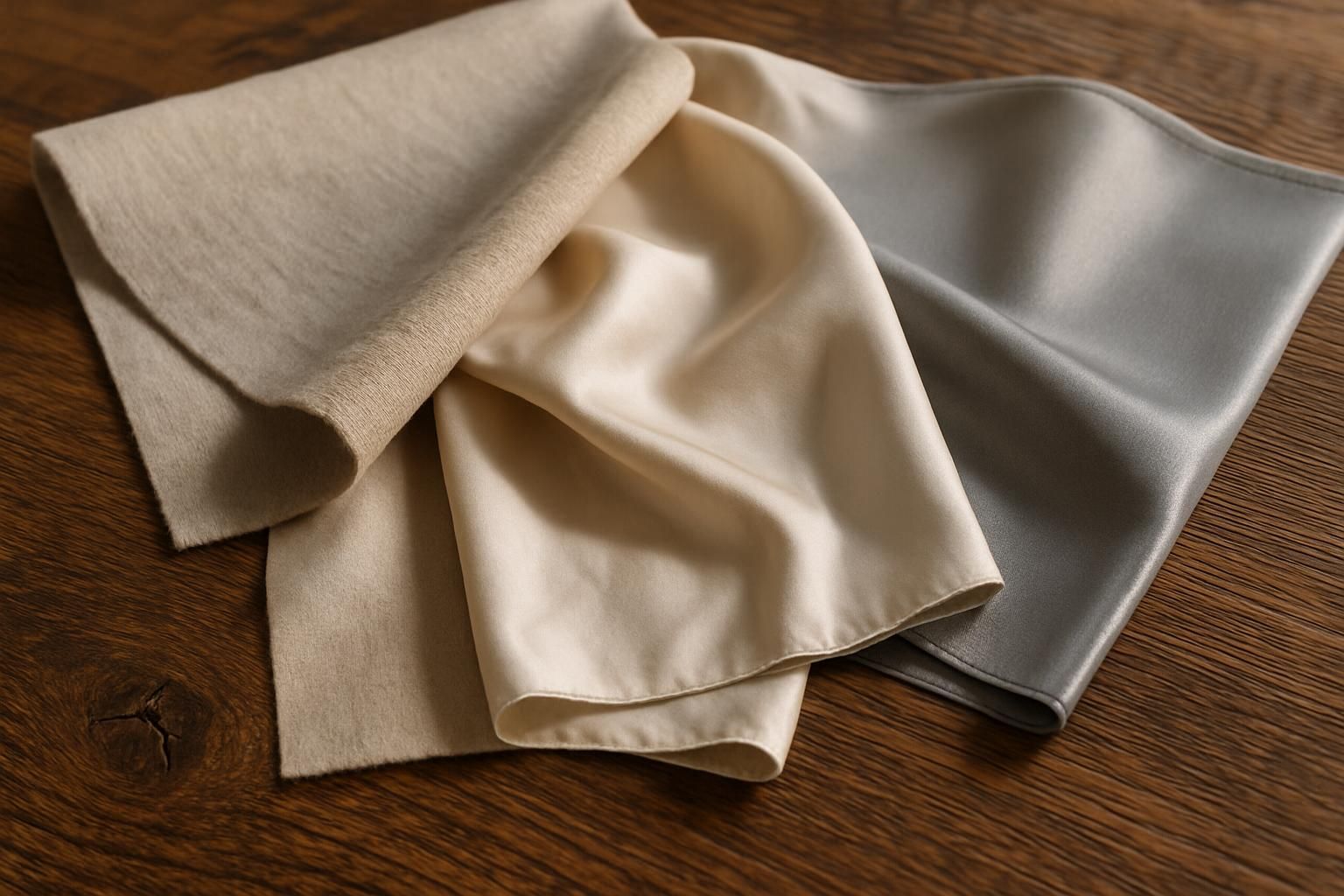
Different fabrics demand their own special care treating them all the same can lead to problems. Paying attention to fabric type prevents headaches later and ensures proper fabric blind care and cleaning.
Cleaning Polyester Blinds
Polyester blinds are easy to care for since they usually resist stains. Regular maintenance involves dusting weekly or using vacuum attachments gently on a monthly basis. For tougher grime, dish soap and warm water work well for spot cleaning. Always check washing instructions before soaking polyester blinds in a detergent solution. Air drying naturally helps keep their shape without wrinkles or shrinkage.
Handling Delicate Materials
Delicate fabrics like wool, linen, silk, or fiberglass require gentle handling. These materials can be damaged by standard washes and need professional dry-cleaning methods. Specialized cleaning prevents shrinkage or fading. Use cleaning products approved for sensitive textiles to maintain expensive blinds without home-based risks. Consult a professional cleaner who specializes in fabric blind care if needed.
Properly Drying and Reinstalling Fabric Blinds
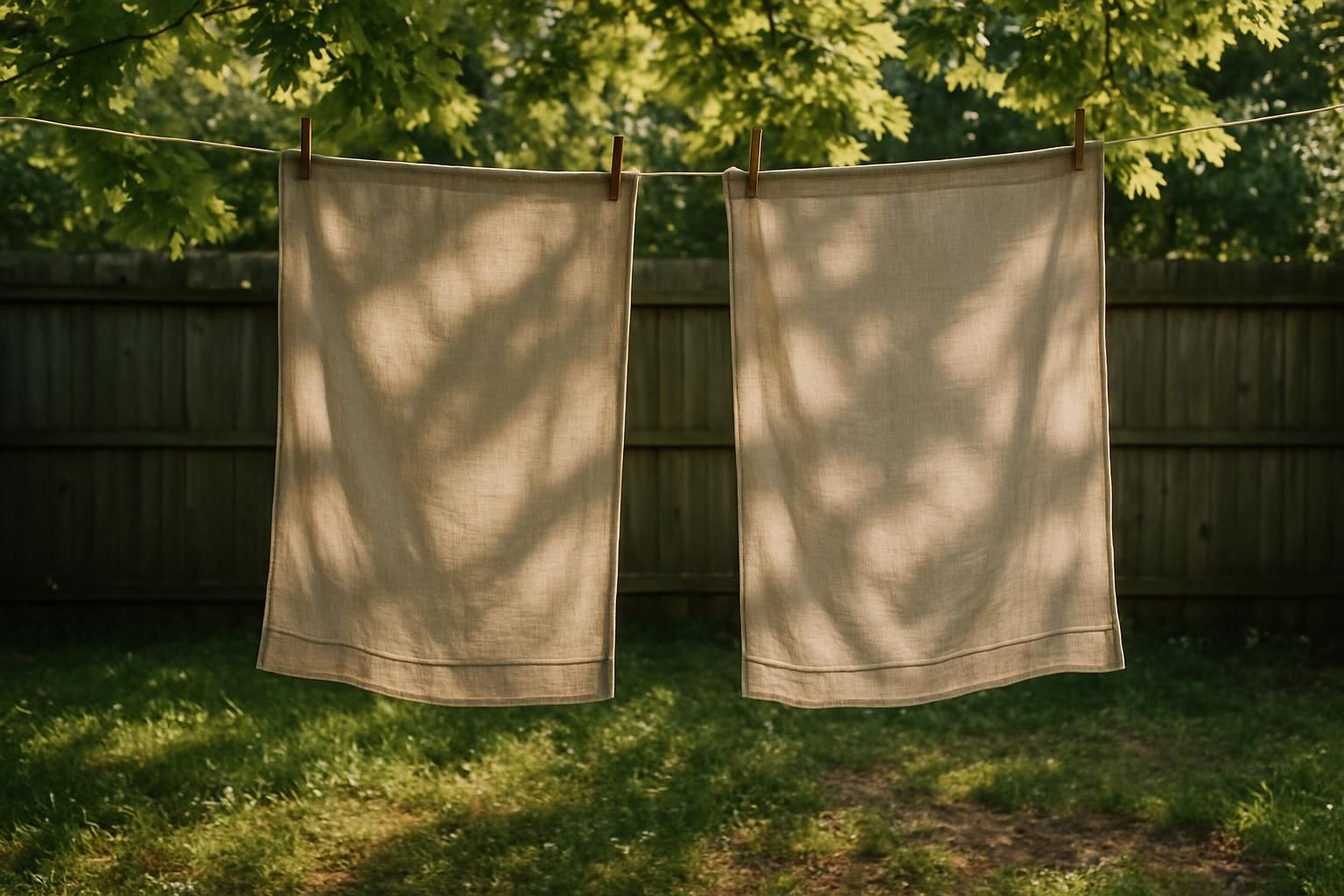
Drying blinds the right way prevents future problems, especially when moisture can lead to mold. Once fully dry, reinstalling the blinds is a simple step to complete the process.
Air-Drying Techniques
Fabric blinds dry best when extended fully and allowed to air out naturally. Direct heat from appliances can cause shrinkage or wrinkles, affecting their neat appearance. Laying blinds across a clean surface helps avoid deformation and ensures even drying.
Correct Reinstallation Steps
After air-drying completely, follow these careful steps for reinstallation:
- Check all hardware removed during cleaning and tighten brackets as needed.
- Lift the dried blinds carefully, supporting them evenly to avoid stretching or damage.
- Align the top rail with the mounting brackets on the window frame.
- Slide or snap the rails into place while ensuring brackets lock securely.
- Step back to adjust cords or mechanisms so that blinds move freely.
- Gently straighten pleats or fabric folds to ensure even hanging.
- If needed, lightly iron polyester blinds on a low heat setting to remove wrinkles.
- Keep windows closed briefly after installation to protect moisture-sensitive blinds.
- Test the opening mechanisms several times to confirm proper attachment without strain.
- Consider applying a thin dust-resistant coating spray after reinstallation to reduce future staining.
Preventing Future Stains and Damage
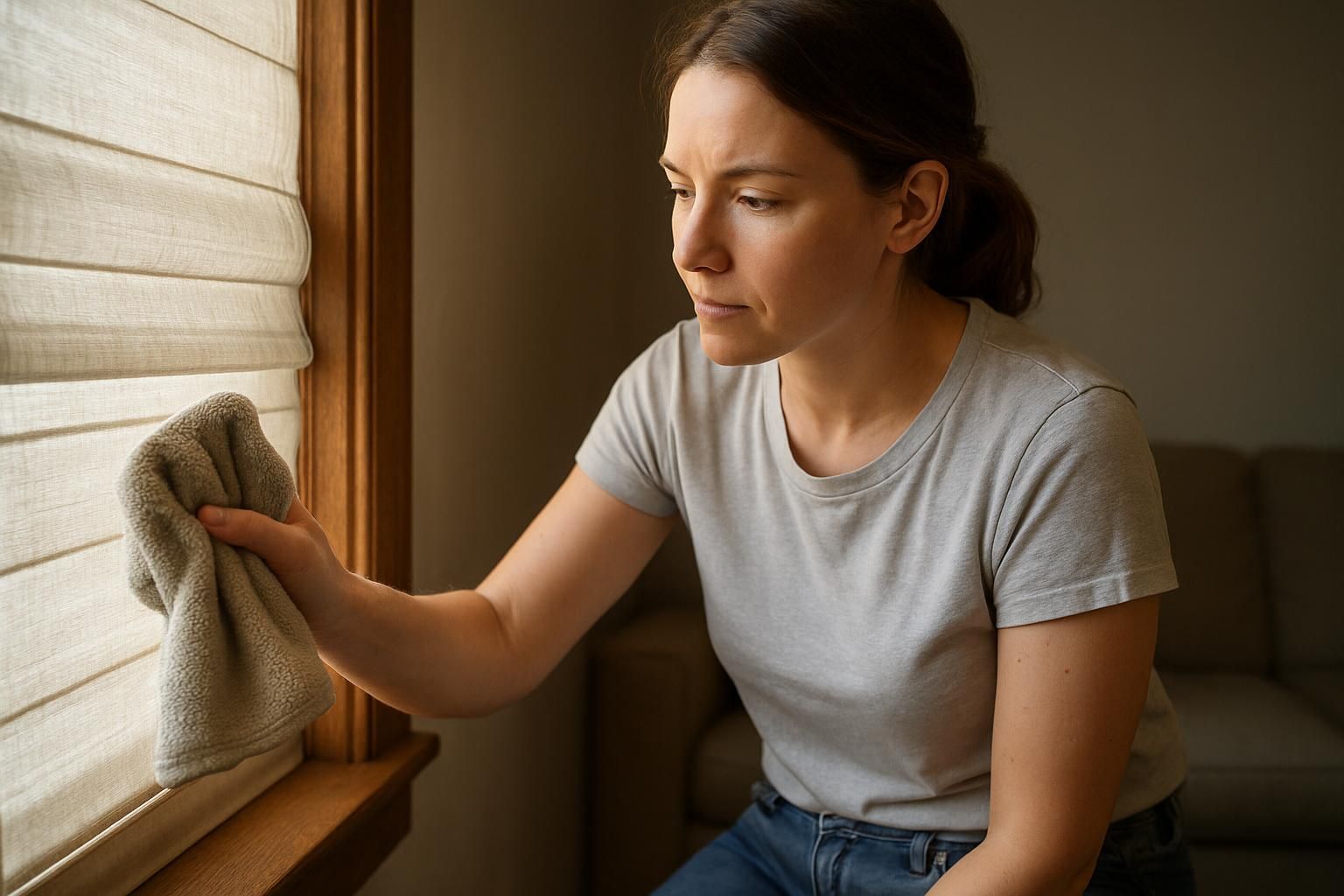
Keeping fabric blinds clean requires planning. Regular maintenance now prevents stains and damage later. Follow these handy tips to keep blinds fresh between deep cleans.
Protective Measures for Long-Lasting Blinds
Applying protective coatings on fabric blinds helps preserve window coverings. Such sprays protect blinds from damage and stains. Home improvement stores offer fabric protectors that are easy to apply. Using white cloths during cleaning prevents dye transfer from colored fabrics.
Cleaning Frequency Recommendations
Regular cleaning prevents buildup and damage. Dust fabric blinds monthly and deep clean them twice a year. In areas like kitchens or bathrooms, consider thorough cleaning every three to four months due to higher exposure to moisture and grease.
Conclusion
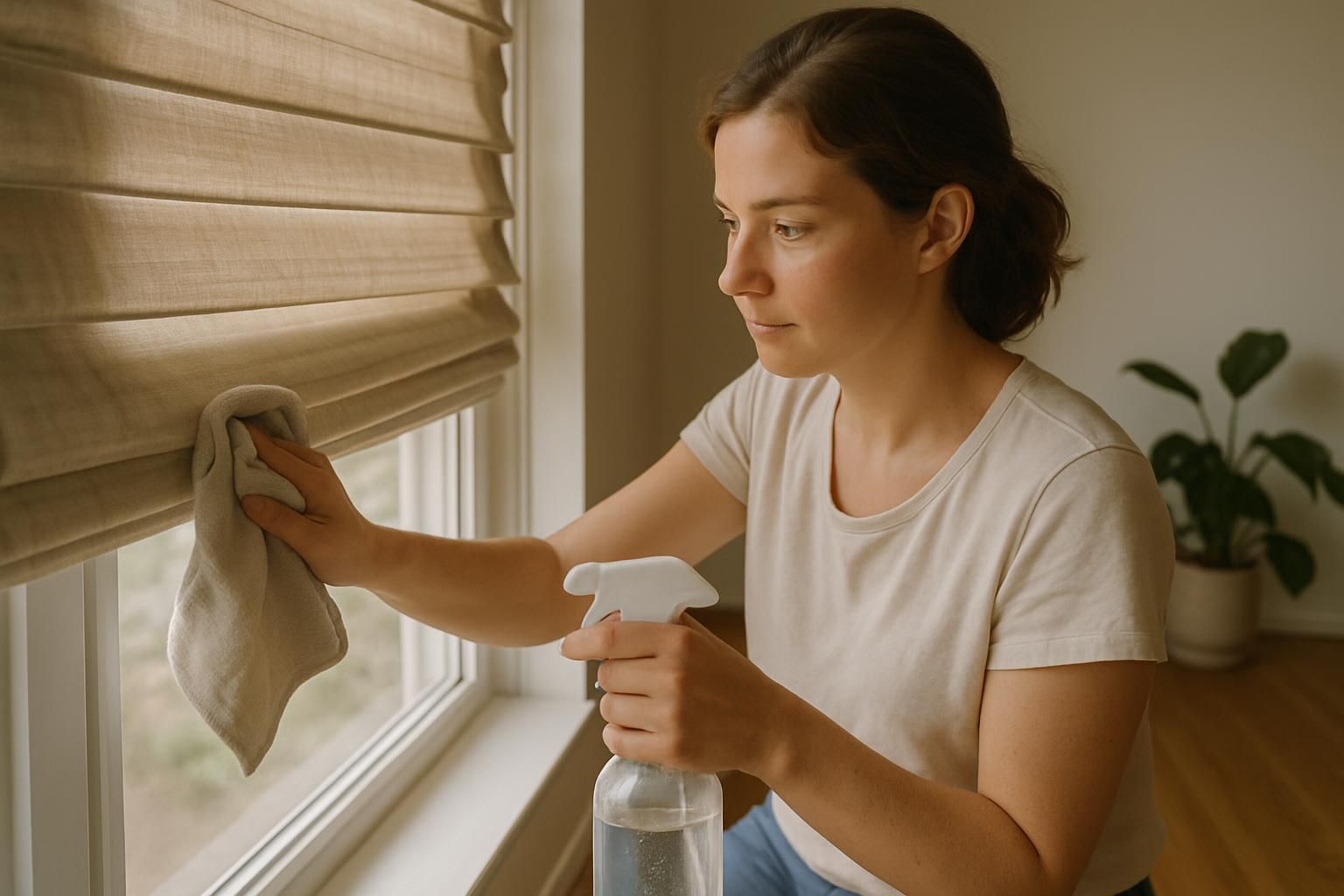
Clean fabric blinds instantly lift a room’s mood and style. Simple monthly upkeep prevents dust, stains, and deterioration later on. For tougher marks, gentle cleaning solutions remove grime without harming the fabric. Correct drying and regular spot checks help avoid long-term damage. These methods offer expert tips for cleaning blinds and represent best practices for cleaning fabric blinds efficiently.
FAQs
1. How often should I clean my fabric blinds?
Aim to clean your fabric blinds every few weeks. Regular cleaning prevents dust buildup and keeps them looking fresh longer.
2. Can I put fabric blinds in the washing machine?
Usually, no—washing machines can damage delicate fabrics or ruin their shape. Stick with gentle hand-cleaning methods like spot cleaning or vacuuming for best results.
3. What’s the easiest way to remove stains from fabric blinds?
Mix mild soap with warm water, dip a soft cloth into it, and gently blot the stain without rubbing too hard. Patience is key as aggressive scrubbing might worsen the stain.
4. Do professional cleaners handle fabric blind cleaning better than DIY methods?
Professionals use special tools and have experience to tackle tough dirt quickly and safely. Homeowners can still achieve good results by following proper steps and using common household items wisely.
This guide combines cleaning fabric blinds at home tips with DIY fabric blind cleaning and professional blind cleaning insights, ensuring proper care for fabric blinds and advanced fabric blind cleaning methods.






